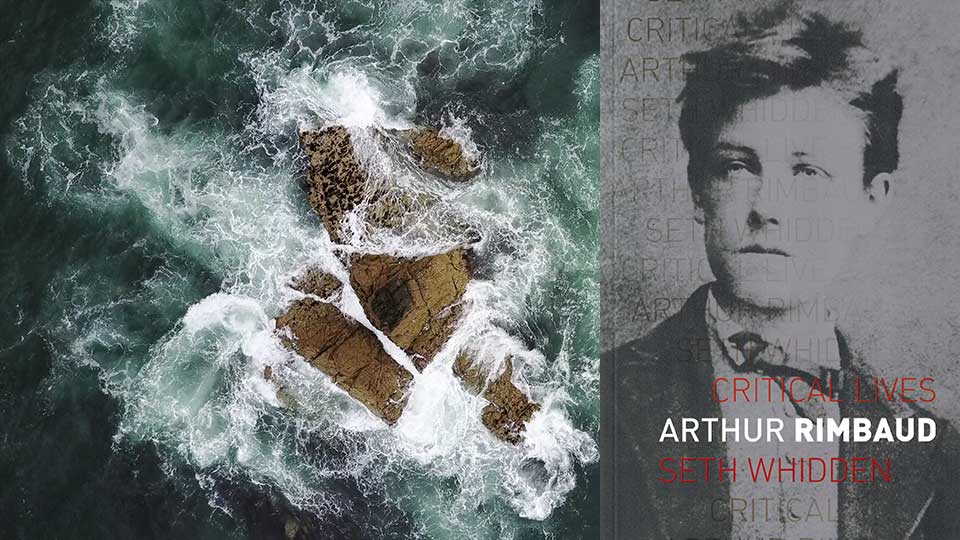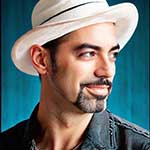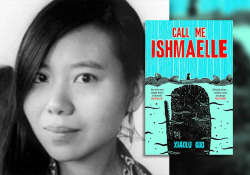Rimbaud’s Spiritual Battle
What becomes a legend most? Great talent, suffering, and mystery . . . three ingredients that French poet Arthur Rimbaud possessed in spades. General readers will be familiar with the broad lines of the Rimbaud legend: child prodigy and enfant terrible who, between the ages of fifteen and twenty, revolutionized modern poetry, only to abruptly stop writing at twenty-one, disappear in Africa, and die at thirty-seven. In Arthur Rimbaud (2018), part of Reaktion Books’ Critical Lives series presenting the work of leading cultural figures, Seth Whidden seeks to fill in the blanks of this enigmatic life. Whidden, professor of French at the University of Oxford and co-editor of a scholarly journal of Rimbaud studies for a decade, loves his subject and knows well the milieu that produced him, demonstrating how the life and poetry of our precocious protagonist inform one another.
At the outset, Whidden emphasizes the importance of flight for Rimbaud’s life and art: away from the provincial mind-set of his hometown, Charleville (which he fled and returned to frequently throughout his short, peripatetic life), as well as running away from what he viewed as the stifling restrictions of the pretty, stuffy poetry of his time: the Parnassians’ “art for art’s sake.” Often quoting from Rimbaud’s original French poetry (and translating it himself), Whidden sketches the development of the young poet’s art from the pastoral, to the political (beginning with the Franco-Prussian War), onto the erotic and mystic. As a voracious reader and prodigious linguist (he would go on to learn/teach English, German, Spanish, Italian, Russian, Arabic, and Greek), Rimbaud was always familiar with the rules of language that he would gleefully break throughout his brief literary career.
As a voracious reader and prodigious linguist, Rimbaud was always familiar with the rules of language that he would gleefully break throughout his brief literary career.
Reading Whidden’s study feels like sitting in on a poetry class, featuring close (at times, technical) readings and perceptive analysis, which deepen our appreciation of Rimbaud’s art. The reader experiences the thrill of being granted a front-row seat to the precocious becoming and premature undoing of our young hero. In addition, we are treated to facsimiles of Rimbaud’s original manuscripts featuring his beautiful penmanship and the cast of characters whose influence he often quickly outgrew: family, teachers, artists, and friends. As a gifted teenager, Rimbaud does what many young poets do: writing to the poets he admires, introducing his work, and announcing himself with supreme confidence.
In one of his two letters referred to as the Lettres du voyant (letters of the seer), Rimbaud famously declares, at the tender age of sixteen:
. . . I am working to make myself a Seer. . . . It’s a question of reaching the unknown by the derangement of all the senses. The sufferings are enormous, but one has to be strong, one has to be born a poet, and I know that I am a poet. This is not all my fault. It is wrong to say: I think. One ought to say: I am thought . . . I is another. Too bad for the wood that finds itself a violin.
Precisely this reckless daring, of one embarking on a tremendous adventure of the Spirit with sublime indifference to its personal cost, is the larger-than-life heroism of Rimbaud that continues to capture our imagination today.
It does not take long for the young visionary with his promise of a “new literature” to secure the attentions of Paris’s literary elite, but, as the saying goes, familiarity breeds contempt. Just as Rimbaud’s radical art gains the respect of literary giants of his time, his gross misbehavior (which Whidden carefully catalogs) proves our boy hero can be quite ugly up close, using and abusing those he encounters like a spoiled brat. Nowhere is this more apparent than in Rimbaud’s disastrous relationship with poet Paul Verlaine, over a decade his senior. “Come, great dear soul, we call you, we are waiting for you” is Verlaine’s fateful invitation to Rimbaud to visit him in Paris, at the start of a violent romantic relationship that would last for two years—leaving the older poet’s marriage in shambles, culminating with Verlaine shooting Rimbaud and receiving a two-year prison sentence for it.
At this point in the horror story, we encounter a more sober, chastened Rimbaud taking stock in the only book he published himself, the influential A Season in Hell (1873). Tellingly, this “notebook of the damned,” as he calls it, is addressed to the devil and makes this mystic announcement:
We are moving toward the Spirit. I tell you it is very certain, it is prophecy. I understand it, and not knowing how to explain it without using pagan words, I prefer to be silent.
After the torturous, unconscious living we have been privy to in his life so far, with its litany of monstrosities, one can’t help but wonder: Who speaks here? It is the Other that Rimbaud alluded to earlier, the Wood-That-Finds-Itself-a-Violin, striking a much-needed note of self-knowledge and, beyond that, recognizing the necessity for transcendence.
The mysterious poet continues his confession from the depths, in “Hell,” addressing the incorruptibility of the soul and his spiritual longing, in this way:
Yes, my eyes are closed to your light. I am a beast, a savage. But I can be saved . . .
Do I know nature yet? Do I know myself? — No more words . . . My innocence would make me weep. Life is the farce we all play . . .
So trust in me, faith relieves, guides, and cures.
A Season in Hell is a hallucinatory, remarkable repudiation of his past life and, with its new clarity, carries a suggestion of transformation and redemption:
. . . the gnashing of teeth, the hissing of fire, the reeking sighs abate. All filthy memories fade out. My last regrets scamper off. . . . A spiritual battle is as brutal as a battle of men.
As Whidden sums it up in his reading of this fascinating text, Rimbaud “arrives at an optimism: ‘Adieu’ is an offering to God (‘à Dieu’), leaving behind Satan and hell, and with them there is at least a suggestion of leaving the West.”
By twenty-one, the “man with soles of wind” had stopped writing poetry and would apply his restless, desperate energy elsewhere, traveling outside Europe and taking odd jobs—including manual labor at docks and quarries, selling everything from coffee to guns and just stopping short of trading in slaves. Asked by a friend around this time if he still thought of literature, an amused Rimbaud replies that he no longer bothers with such things, regarding it as “dregs” from a past life of general drunkenness. Whidden is keen to emphasize, however, that Rimbaud still wrote but that it was far from literary, more of an explorer’s means to describe other worlds. For the same reason, the ex-poet takes up photography in Africa a decade later; a few evocative pictures from this inscrutable period of Rimbaud’s life are reproduced in Whidden’s stylish, slim volume.
Ironically, just as he has definitively turned his back on literature (after desperately yearning to make a name for himself as a feverish youth), Rimbaud’s work was beginning to appear in print and his name circulating with mounting appreciation. In an anthology entitled The Damned Poets, Verlaine generously introduces his long-lost friend (declared dead several times) to a new and sympathetic audience, including in the book a number of poems by the child-genius, which would prove influential—even inspiring the symbolist movement.
Although Rimbaud was outliving himself in a sense, he was also dying in another and wracked with regrets. In a letter from Africa sent to his mother (a relationship that grew less embattled as he matured), he makes this plaintive confession:
I regret having never gotten married or had a family. . . . I’m condemned to wander. . . . What’s the point of all these comings and goings, this exhaustion, these adventures with people of strange races, these languages that fill up my memory, and these nameless difficulties?
To add insult to injury, the mute poet now learns he is to become an amputated wanderer. Here he is again, wailing:
. . . how tiring and how sad when I think of my old travels. . . . And, now, I’m a one-legged cripple. . . . I who had just decided to return to France this summer to get married! Goodbye marriage, goodbye family, goodbye future!
And before he can fully process this major life change, his cancer spreads and he rapidly deteriorates. Rimbaud’s final weeks before his death, at thirty-seven, are heart-rending: he weeps, is in a daze, and still dreams of future plans.
The last chapter of Whidden’s gripping study is entitled “Afterlives” and considers the many posthumous lives of an unfathomable character who died and was reborn while still alive. We learn of forgeries, influences, and his undying connection to artists and readers alike (apparently, he continues to receive enough mail for authorities to place a mailbox in his cemetery at Charleville-Mézières).
Might it be that the difference between diabolical and divine inspiration is the duration of pleasure afforded?
Despite his uncommon achievements, it is difficult not to regard the life of Rimbaud as a kind of cautionary tale or moral fable. Claimed by the surrealists, he was pronounced by their leader, André Breton, as “a god of puberty.” Perhaps this blasphemous epitaph gets at the pitiable heart of it all: that such an immense gift should have been entrusted to rebellious, destructive adolescence and emotional immaturity—in short, one inadequately suited to it. As we see in his abbreviated life example, debauchery, eventually, ushers in virtue; but there are less vicious paths, such as patience. Also, might it be that the difference between diabolical and divine inspiration is the duration of pleasure afforded?
Contemplating this almost mythological life leaves us meditating on larger questions, spiritual and existential. Who was Rimbaud? What is the nature of inspiration? Were the sacrifices his vocation entailed worth it? (By this I mean the protracted torment inflicted upon Rimbaud and those in his inner circle). Could it be that, from the start, the thing he sought, this demon-angel, was always just outside the page? That, after swimming the length of the alphabet, with fine gills and deranging senses, he created an opening for others but a trap for himself? If so, then slipping through those watery bars was imperative, a chastened mysticism—and freedom to write in the air, to be . . . human.
Could it be that, from the start, the thing he sought, this demon-angel, was always just outside the page?
To his credit, Whidden offers no easy answers, honoring the fundamental mystery at the core of Rimbaud’s fate and suggesting that the answer to these riddles, and others raised by his extraordinary life, are to be found in his art.
Fort Lauderdale, Florida
















